IT IS NOT EVERY DAY that a major German automaker calls up an architecture firm and asks them to help them understand their own future. Nor is it every day that an architecture firm proposes an urban ski slope as part of a power plant—in the middle of a city with no mountains—and meets with success to see it get built. Either of these two items would likely mark a significant milestone and force-multiplier for a relatively young-ish architecture practice. But for Bjarke Ingels Group (BIG), headquartered in Copenhagen, Denmark, such projects, and client opportunities now seem par for the course.
BIG is, without a doubt, the single most exciting architecture firm in the world today. And the architecture profession’s most innovative standout. So it serves as a unique opportunity to hear from this firm what makes BIG’s work tick—how this architecture firm thinks, collaborates, innovates through the lens of its past and current projects and its cultural outlook.
It was, therefore, a special opportunity to hear BIG principal, Kai-Uwe Bergmann, speak at a GRAPHISOFT conference earlier in the year and to have the opportunity to talk privately with Kai after the event. What follows is our conversation.
The Interview
(Architosh) You stated that Google already had a single architecture firm for its headquarters project and it wasn’t working for them. They are used to “engineering culture” where, as you said, you throw 10 engineers into a room, and you demand that they collaborate and solve a problem. So Google hires BIG and along with another firm and things are much better and the project moves ahead.
What is different about your company’s outlook with respect to collaboration? Is this already in your DNA to work and think differently about collaboration?
(Kai-Uwe Bergmann) Yes, I think so. So I think that BIG is in many ways the persona of Bjarke Ingels. And so you almost have to go back to Bjarke to understand the values that BIG is founded on work. One of Bjarke’s greatest strengths is the act of “active delegation” and that he knows what he is really good at and what other people are really good at.
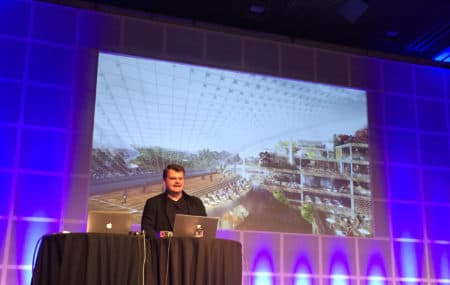
01 – Kai-Uwe Bergmann, principal at Bjarke Ingels Group (BIG) talking about working with Google on their new corporate campus.
Bjarke’s confidence in himself has allowed him to be surrounded by people that were both ambitious and intelligent and when you combine all of that it’s like the perfect storm of possibilities. I think the culture that we have created is one in which everyone can do anything. And that’s something that also exists in America; what it is then tempered by is this type of social responsibility that is very Scandinavian. So when you use your ambition and force for design and intelligence, you do so for the greater good and for society. You do it because it can actually improve our collective lives. And this kind of social responsibility married with this “can-do” spirit is a pretty unique thing to BIG.
Bjarke’s confidence in himself has allowed him to be surrounded by people that were both ambitious and intelligent and when you combine all of that it’s like the perfect storm of possibilities.
How does that unique BIG culture portray itself at the project level?
So when we start our projects, we always start by asking how can this individual project—driven by individual ambitions and fortunes, you eventually have to make some money for someone—how can that work for the greater good, for the city it is in, for the region, or the larger issues?
So the word “alchemy” as you used it in your talk, is that word something that Bjarke personally invested into the culture of BIG?
I think Bjarke had coined the phrase “programmatic alchemy.” The Moutain project symbolizes this. So you could build an individual parking house, an individual residential project and each would have its own merits. But by combining the residential project with the parking garage, you accentuate the very desires of one—which is south facing units. Then you have the generosity of the outdoors with the generosity of the indoors. And then you figure out how to manage all the challenges that come with it. So I think that programmatic alchemy is something that we look for, we are looking for a benefit—like the power plant with the ski slope—we are looking for something to benefit the greater good by combining sometimes strange things together. (image 02 – 03)
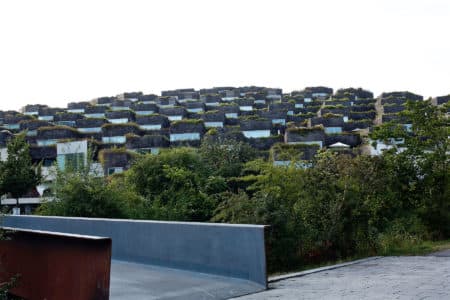
02 – BIG’s “Mountain” project exemplifies Bjarke’s “programmatic alchemy,” says Bergmann. (Image: Naotake Marayama, distributed under CC-By 2.0 License / Architosh. All rights reserved.)
I was surprised to learn that the power plant that is also a ski slope project, the Amager Bakke, is just now being built. Was the delay due to technical issues?
No, it was a political issue. It was a project that was dormant for two years because one political party was suing against it happening because they wanted to have more recycling and less burning. In Copenhagen you burn about 55 percent of your trash, you recycle about 45 percent, and the tiny rest is landfill. And what they wanted to do is flip that ratio, so you recycle more and burn less. So that political debate took two years. That was eventually decided in favor of more burning and also being open to more recycling as it improves. But it just goes to show you that the Danes, because they are such a small population, on such a small piece of land—they have no ability to use landfills—every space is actually occupied. They are one of the most innovative cultures about what to do with trash.
Do you think that the success of this project could spawn more versions of it in Denmark or other countries?
Yes, I do. Think of it this way. Architects generally work in budgets in tens of millions of dollars, sometimes hundreds of millions. This building in nearly in the billions. And these large energy plants are being built all over the place. And generally, architects are not included in these conversations; and there is an urban responsibility of finding out how these power plants get integrated into cities. Cities, as they grow, are also engulfing the existing power plants. And we need to find out how to coexist with the various systems that we need.

03 – The Mountain project from the canal. (image: Susanne Nilsson. Distributed under CC-By 2.0 License / Architosh. All rights reserved)
That’s why I think—and architects love to whine about how bad things are…but actually if you think about it, you have these billion dollar projects—stormwater mitigation, resiliency design, train or road systems, and bridges and power plants are amazing areas for architects actually to get involved in.
Where is innovation happening on the Google headquarters project and what is BIG learning?
Google doesn’t limit themselves concerning what is currently existing for materials and building systems. They have a warehouse dedicated to building and testing every single building system BIG comes up with. So you can imagine the cost associated with this. This project situation is a dream for any architect. We have literally tested 25 different building systems that have never been tried before, to see how they can actually integrate into the project.
The emphasis I see, or the things we have learned the most, through this integration we have widened our ability to integrate using different materials and Google as a client is willing and has the pocketbook and is actually ready to test those new ideas.
Yeah, it sounds like how they would maybe test their software products or even their own phones, for example. And very product-type oriented.
And you can imagine that they would like to patent then roll it out into the building system. The construction industry as a whole doesn’t get disrupted enough, and these technology companies see how large of an industry it is, and they could seriously do some very interesting damage.
I would look forward to bringing a new VC type of approach to thinking about new building systems. The Hyperloop is an entirely new transportation system and entirely privately funded at the moment. So we have Amtrak, and we have NASA, and right now the innovation doesn’t occur in those institutions, it happens in the private sector that is pushing for space travel or people travel.
The construction industry as a whole doesn’t get disrupted enough and these technology companies see how large of an industry it is and they could seriously do some very interesting damage.
Those are governmental institutions. And some write that the government is working at the speed of Government 1.0, but it needs to move up to Government 2.0 because Government is no longer fast enough to keep up with the pace of innovation.
I do think that is true. I think governments are amazed by the speed in which they need to react to things. As in regards to the private sector, that was the relationship of Mountain View to Google and seeing that Google was on par or larger than the entire city retail district of Mountain View. And suddenly Google needs to think about all the systems that are connected to [it] because the government just doesn’t move quickly enough. And yes, I do believe movements are being made about how governments may or may not be able to function in the future.
In Denmark, how substantial is BIG’s impact on other architecture firms?
To be fair, I think the most significant impact we have had is in all of the kind of baby BIGs, meaning all of the people that used to work at PLAT or BIG and have opened up their own offices. There is a whole generation of 10-15 people offices that have all been born out of the trailblazing that PLAT or BIG did in their day.
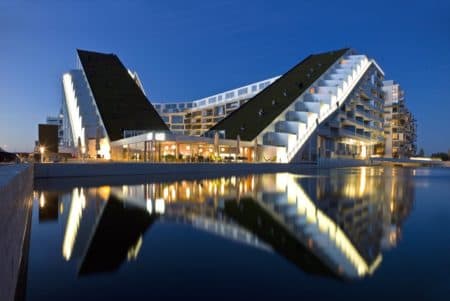
04 – 8 House is another highly prized architectural innovation in Denmark by BIG. (image: Jens Lindhe. Distributed under CC-By 2.0 License / Architosh. All rights reserved.)
As for our colleagues, we by no means propose that we know everything about the business of innovation in architecture, we are still learning from our new experiences and Copenhagen as a city. I think time will tell how the birthing of all these other offices like We and Third Nature and others will develop into a potential movement.
But your impact globally is huge. It is not every day a car company like Audi comes to an architect and says, we think you are going to put us out of business, help us.
It does tell you that there are some interesting people at Audi asking those questions. And ensuring that they get the greatest critics—and of course, we coming from Denmark are going to prioritize bicycling over driving—and so kudos to them for asking us to look at this…and then we just have to see if they take things to heart and how they change as an organism.
This smartStreet technology that you showed was that technology that BIG created or did Audi already have that developed?
We developed the LED streets, the smartStreet, that was that little proposal and the installation was done for Art Basel Miami. And we were looking to see, during Mayor Bloomberg’s tenure, if we could take a city block in New York City and actually do it.

05 – West 57 is BIG’s noteworthy entry into the NYC architectural market. (image: Cristina Bejarano. Distributed under CC-By 2.0 License / Architosh. All rights reserved.)
We haven’t been able to take this proof-of-concept to the street. But that would be the next thing. There are some really interesting advancements by a Dutch guy named Roosegaarde who has created a mix in the asphalt that absorbs the sun’s rays during the day and then creates glowing bike paths at night so that cars know exactly where to stay. So there are different ways to make streets smarter than they currently are.
So you mentioned BIG Engineering, a new group within the company. Will ARCHICAD be the platform for BIG Engineering as well?
I believe so. The entire Copenhagen office runs on ARCHICAD. There are of course some engineering software, like Tekla, but the idea is for them to assist the architectural process from the point of concept so they would need to work in both ARCHICAD and Tekla.
The last time I spoke to your office, the firm was very big on Rhino and Grasshopper. Is that still the case?
Absolutely. But I think I counted once that we use about 35 different software products at BIG. And this is partly because we are recruiting people from all over the world. So whatever they learned at University that’s the skill-set that the people come into the office with. As an employer, you can’t cherry pick people with the same software skill-sets that your company has because someone might be an awesome designer or architect but has an entirely different background and set of skills.
So our approach is to be super inclusive of everybody’s skills. And then we have an internal school, or what we call BIG School. Every two weeks someone who is the maestro of a specific software tool teaches it to everyone else. That way we try to cross-fertilize the knowledge throughout the firm.
As an employer, you can’t cherry pick people with the same software skill-sets that your company has because someone might be an awesome designer or architect but has a completely different background and set of skills.
When it comes to tools, processes or what you call “pipeline,” I see a lot of waste in the industry. What is your take on that?
We do ourselves a disservice. And that’s partly because architects never learn business in school. And unless they have a very good mentor in the professional world they will never learn it. And so they make a ton of mistakes. I think that architects fantasize about being artists and therefore “business” is kind of a bad word. But as you mentioned it’s a service and it can be creative and artistic but it sure as heck better be business conscious. So learning how to balance the aesthetic decisions and drive and vision with those that are just common sense is important. And no architect should take a job and not get paid.
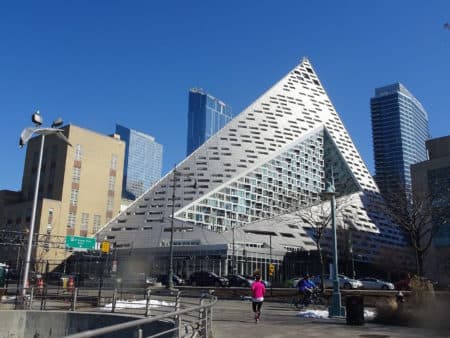
06 – Finished view of West 57 in New York City. (image: Jim Henderson. Distributed under CC-2.0 License / Architosh. All rights reserved.)
So I think of the Guggenheim Museum competition in Helsinki where you had 1700 applicants in an open competition where you will have one winner. Think about when you add the hours for people working for 2-3 months in groups 2, 5 or 10 people, to submit all of that work; we could have used the same brain power to crack a problem like “how do we feed people?”
So that is a loss of joy and brain-power to contributions to society. And I think that architects get into this recognition thing that this is the only way a young firm is ever going to break through. So there are a lot of barriers that we have created. I kind of look at it as the X-Prize. Engineers have the X-Prize, and they are solving things. Architects need to have their own X-Prize to solve things, and we would get a lot more respect in society.
Image Credits
Format equates to “party with copyright” / “party with reserved rights of use.” (eg: image: FJMT / Architosh. All rights reserved.)
Title image credit: BIG’s “8 House.” ( © Mike Davis, FAIA / Architosh. All rights reserved.) Not credited images are copyrighted to Architosh. All other images are copyrighted, as noted in the image credits.

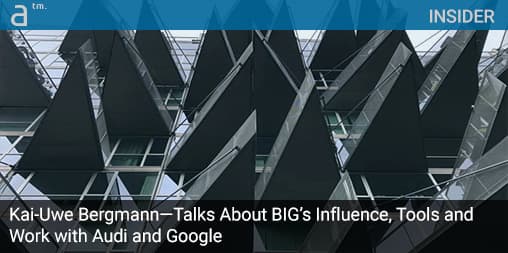


Reader Comments
Comments for this story are closed